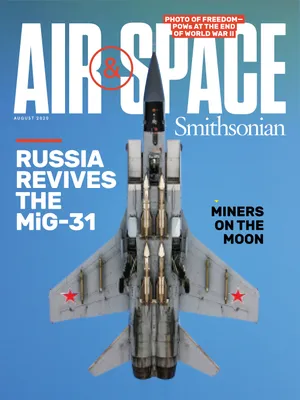A Kinder, Gentler Sonic Boom
NASA’s X-59 supersonic research aircraft is coming together for its maiden flight next year.
:focal(816x390:817x391)/https://tf-cmsv2-smithsonianmag-media.s3.amazonaws.com/filer/5e/dc/5edc1715-3d7b-440f-9d21-c44f8ba119f4/32h_aug2020_illox-59_nasaquesst_live.jpg)
Sonic booms proved to be a bust for commercial supersonic aircraft, which were banned from flying over the continental United States in 1973. But NASA’s newest X-plane, the X-59 QueSST, which is expected to fly in 2021, will provide data that will allow engineers to scale down those booms, so that they sound more like muted thumps. The X-59 has an elongated fuselage, so that the shock wave it generates is likewise stretched, rising more slowly—therefore exerting less pressure on the eardrum.
The aircraft was cleared for final assembly in late 2019, and, in May, the program reported its latest milestone when GE Aviation announced that the first engine for the X-59 had been shipped. While Chuck Yeager’s X-1 used a four-chamber rocket engine to accelerate beyond Mach 1, the X-59 will use the F414-100 turbofan—providing 22,000 pounds of thrust—which is adapted from the engine that powers the Navy’s F/A-18 Super Hornet. “A single-engine aircraft is attractive because it has a smaller footprint on the airplane,” says Ray Castner, the NASA propulsion lead for the X-59. “It takes up less space. Sonic boom is all about volume and shaping.” Another significant aspect of the engine design is its placement on top of the airplane, so that the delta wings block shock waves from the nacelle from reaching the ground.
Meanwhile, significant progress has also been made on the X-59’s frame at Lockheed Martin’s Skunk Works. “All the major structure of the fuselage is complete,” says Jay Brandon, the X-59 chief engineer at NASA.“It’s in the process of getting its skins put on.”
Though it looks futuristic, some pieces of the X-59 are hand-me-downs—landing gear from an Air Force F-16, a control stick from an F-117 stealth fighter, and a cockpit canopy from a NASA T-38 trainer. “The big innovation on this airplane is the shape,” says Brandon. “So, it’s basically a cost and schedule mitigation to try to use things that have already been there. It’s not inventing things we don’t need to invent.”
/https://tf-cmsv2-smithsonianmag-media.s3.amazonaws.com/accounts/headshot/mark-strauss-240.jpg)

/https://tf-cmsv2-smithsonianmag-media.s3.amazonaws.com/accounts/headshot/mark-strauss-240.jpg)